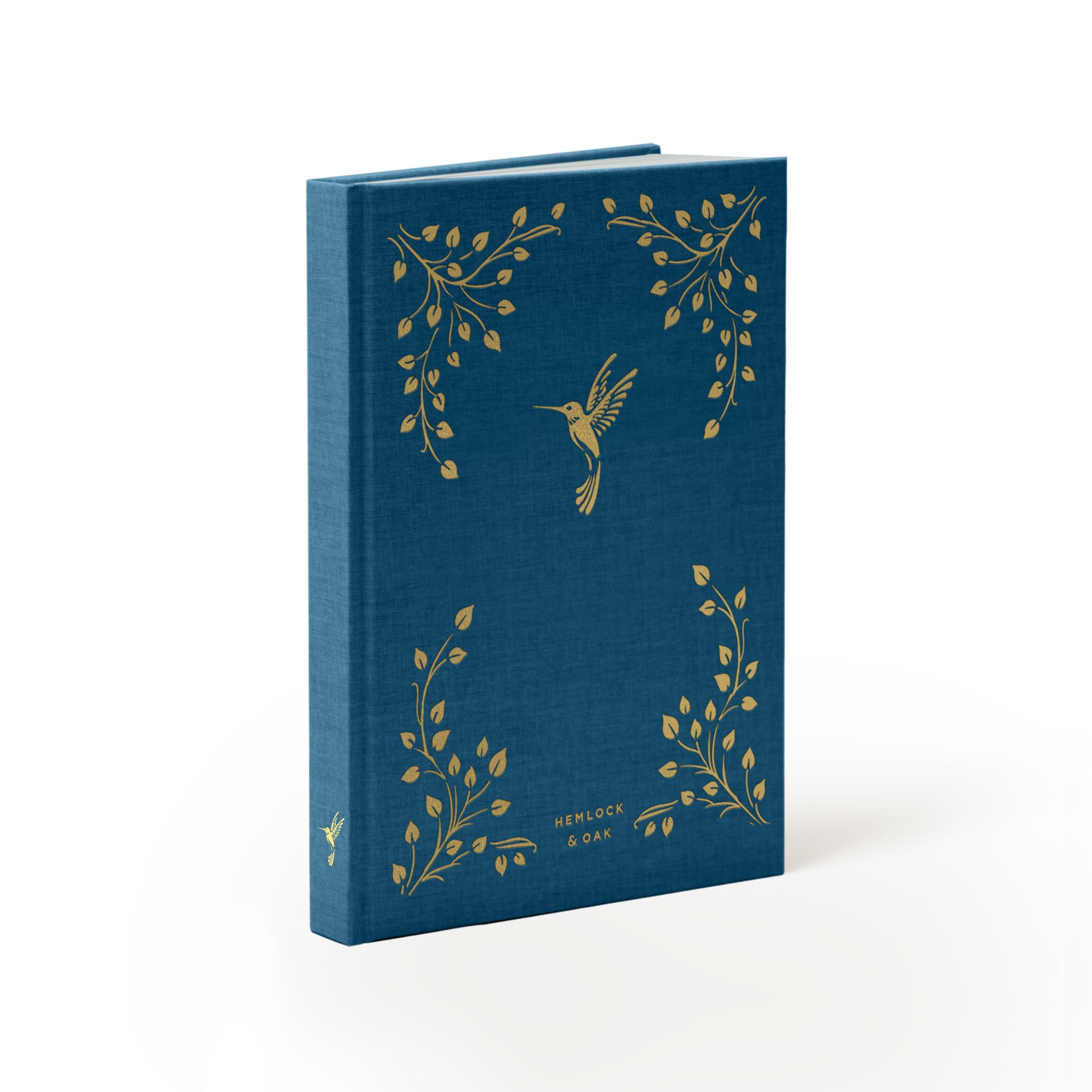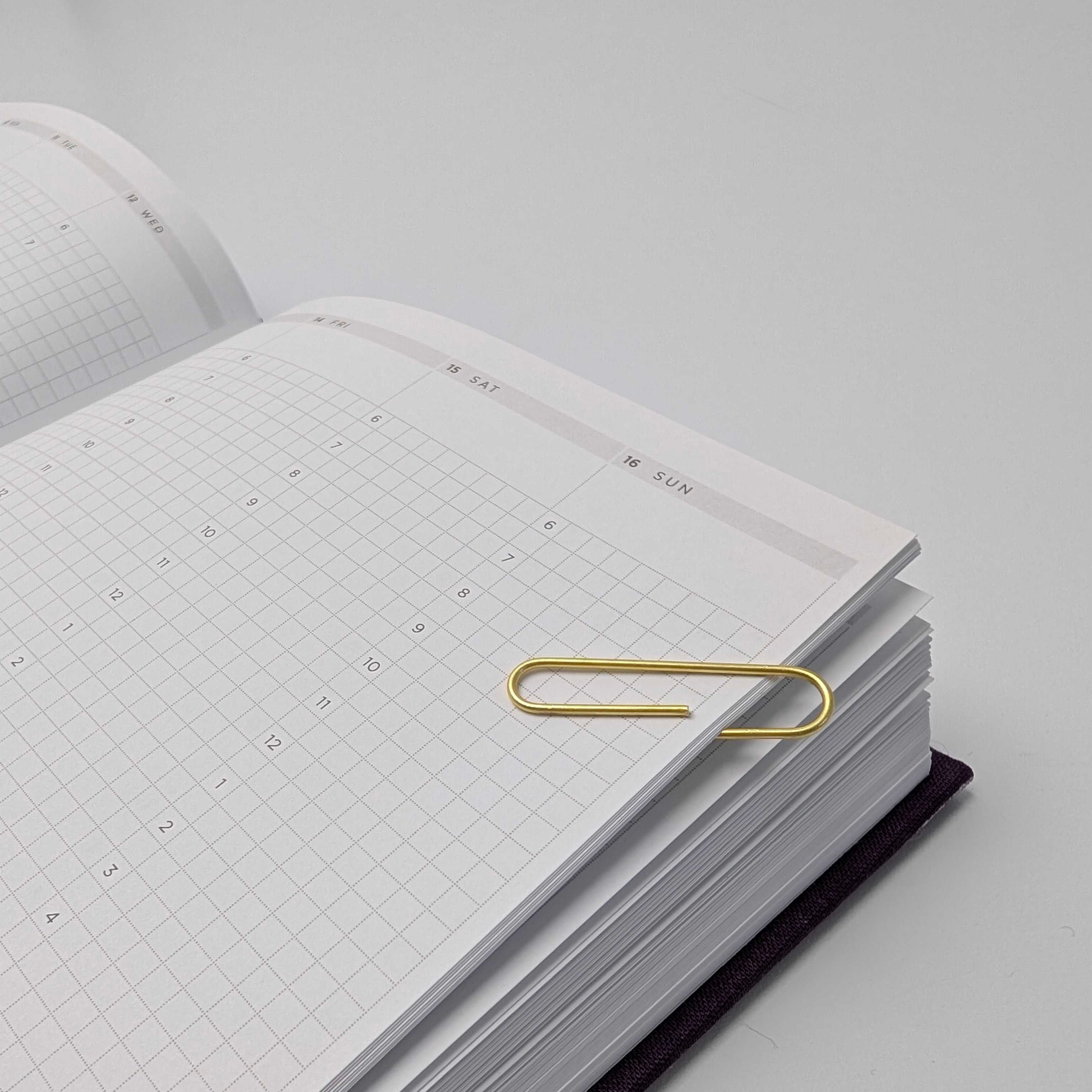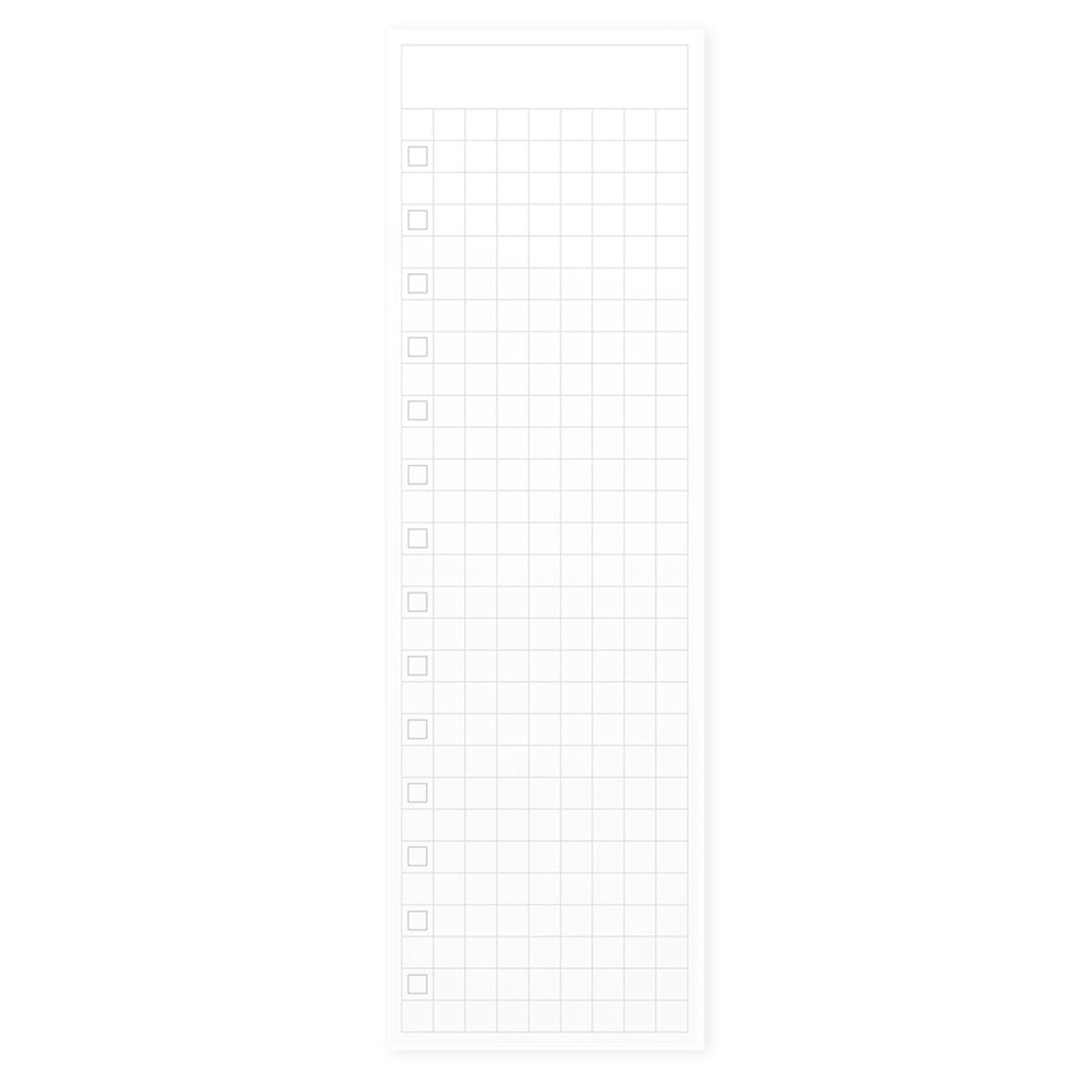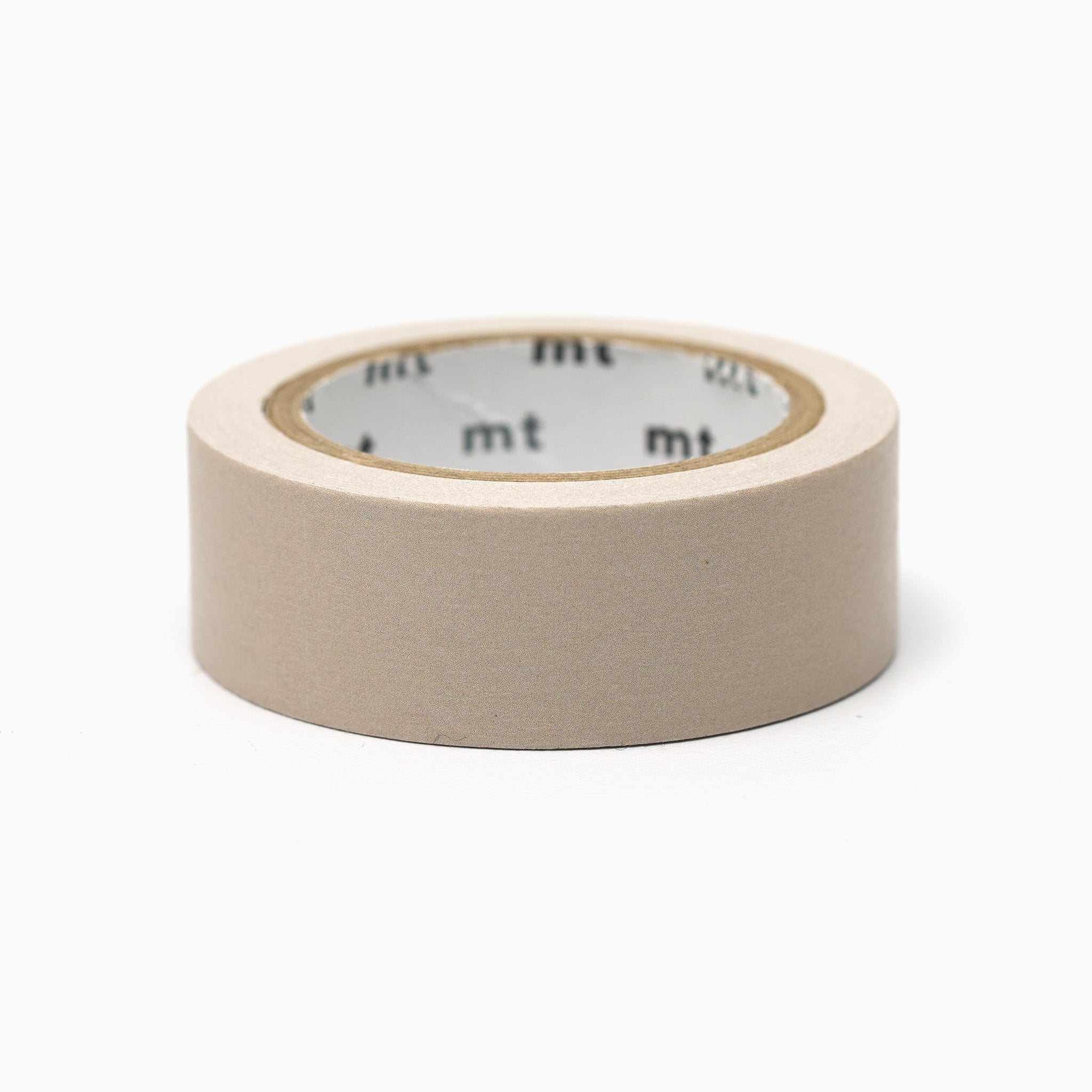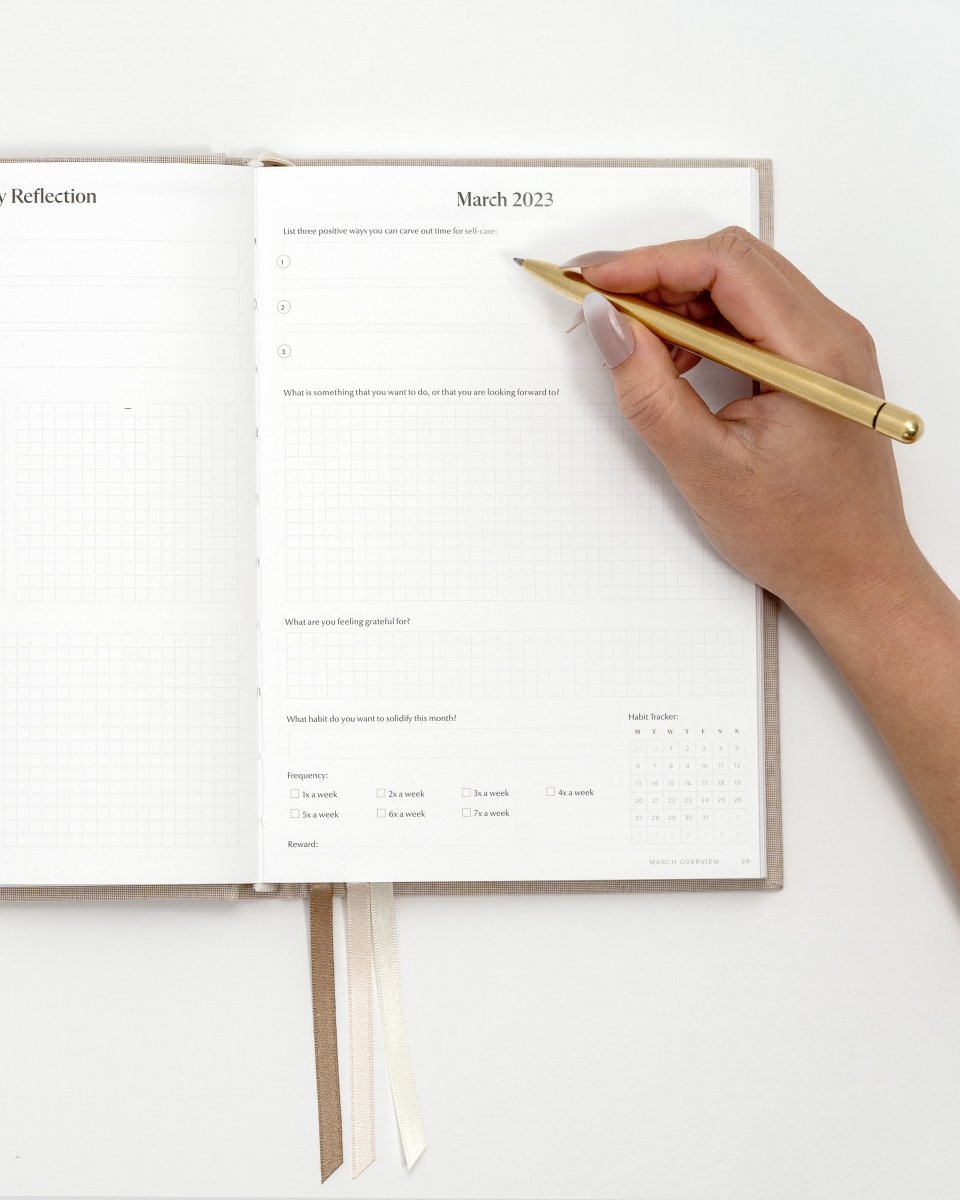

In this Article
Using traditional paper planning helps people become better organized, mindful, and fulfilled. Unlike apps, the mind-to-paper phenomenon is more powerful and focused. [1]
But there are so many ways to plan, and millions of planners out there. What really matters at the end of the day? And how do we select the right planning tools for ourselves?
So if you're feeling a intimidated at the thought of stepping in, or want to know more about paper planning, read on!
A Brief History of Planning
There is only so much information we can hold in our mind before we are overwhelmed (mental overload). And this is not a new phenomenon.
It's no surprise that our ancestors had similar struggles. Keeping a personal 'planner' dates as far back to the Roman Times. There are also records showing that 9th-century Chinese scholars used some form of them as well, such as Lio Ao.
These early planners had many uses, like keeping track of travel, appointments, daily events, tasks, and spirituality. They were similar to modern planners or journals.
Literacy rates increased and journals became popular. People used journals to record daily events, write accounting records, keep track of farming tasks, or reflect on their spirituality.
With further modernization and accessibility, such as during the renaissance, people began to use diaries to express opininons and thoughts without the intention of publishing their writing. By the 18th century, keeping a journal became widespread.

Flora Emaretta Parsons' Daily Journal in 1874, logging her life as a school teacher in a Standard Diary
In 1773, Robert Aitken published what is claimed to be America's first daily planner, resembling modern planners with its week-by-week layout and sections for expenses, appointments, and memos. Although it was not immediately successful, the widespread use of planners and diaries emerged after the Civil War. These planners, often referred to by names like the Standard Diary and the American Diary, were used across various social classes for productivity, social etiquette, and self-improvement.
Of course, the commercialization of journals became necessary to fulfill demand, and companies such as Letts began producing large format diaries. By the 1850s, these diaries were being sold in thousands each year.
What is Paper Planning?
Planning encompasses a wide range of activities that help us take control of our lives. By helping us balance core tasks, personal and professional goals, as well as self-care, planning helps create order out of a chaotic stream of priorities. It can free up precious resources so that our time can be used more effectively.
Planning can help us look to the future and review the past, so we can make good choices about how to spend our time in the present. It also involves the intentional action of taking time out of your day to focus on how to spend your time on other tasks. This is important, and can often be neglected. But it’s a great use of time, and with practice, your planning practice will become more effortless and effective.
The art of planning extends beyond the function of helping us plan our days. That is, it's not just about planning for birthday anniversaries, due dates, or grocery shopping lists.
It can also serve as a creative outlet. For some, planners are used more for journaling - for instance, to log memories or track habits. We’ll get into more details on this below.
A fantastic range of tools and planning systems exist in the world, and serve a multitude of planning goals, styles and needs.
What is the Best Planning Method?
The "Best Planning Method" is highly personal, but you can never go wrong by planning with your personal values in mind.
Your personal values are your 'belief system': ideas that are important to you.
Examples of personal values might be:
- Well-being
- Creativity
- Solitude
- Social time
- Financial wellness
- Competitiveness
- Fitness
- Adventure
There are no "right" or "wrong" personal values. Knowing what is important to you will help you make choices in your daily life that bring you fulfillment.
While your preferred planning methods may evolve over time, knowing your personal values can help you understand what works for you.
For instance, if you are a person who needs to express themselves creatively, bullet journaling or creative planning might work better for you.
Or if you value your health and wellness, a planner that allows you to track your fitness and meals could be crucial for your needs.
To get started, ask yourself some basic questions:
- How do you envision your ideal life? Close your eyes. If you had your life exactly as you wanted it, what would it look like? It doesn't matter how simple or "out-there" it is. Whatever you imagine rings truth about your core values.
- Based on your ideal life, what are your most important values? Let's say that you imagined something wild, such as being a famous actress with a beautiful home. Focus less on the plausibility and more about what you've imagined says about your values. Being famous might imply that you value social connection and validation. And having a beautiful home might mean that you value your surroundings. Alternatively, it might mean that you value success.
- Once you have narrowed down your these values, what do you want out of your personal planner?
Are you looking to work towards something specific? Manage your weekly schedule? Streamline processes? Work on a hobby? Build new habits? All of the above?
It can start to feel overwhelming if you haven’t done this recently (or ever), but this is exactly the type of thing planning can help with.
If you’re just starting out, start small. You have full control over the level of detail you get into, so don’t make it daunting. If your planner has a guided journaling section, don’t pressure yourself to complete it right away. Do it when you are in the right mood and headspace.
In fact, it’s probably better to start at a high-level before drilling down into specifics. It’s equally important and to regularly revisit, reassess, and revise your planning process.
Let’s start by covering some basics, and then get into some detail!
Planner particulars
-
What planner layouts are out there?
A planner layout is personal, but what’s out there? It all depends on the design.
A planner can have monthly overviews, weekly & daily spreads, space for time-blocking, to-do lists, habit trackers, journaling sections, focus and goal areas, and so much more.
Planners come in many different layouts and configurations, such as vertical layouts, horizontal layouts, or combinations of these. Blank, lined, grid, or dotted notebooks are also all used to plan with ultimate creative freedom.
Below is a list of common planning parameters and related specifics.
-
Planner layout types - Some planners have guided sections which vary in depth and prescriptiveness, whereas others focus solely on planning pages. Some planners use both journaling and goal setting pages. Others focus more on the functional side of planning.
- In terms of the graphical aesthetic of a planner, some designs are common to most planner brands.
- Vertical layouts generally present the week over two pages, with vertical columns for each day. Columns vary in size, but 1.5” is a standard which fits many sticker kits.
- Daily Planners: these layouts provide more space to plan, and come in various configurations. There might be one full page per day, or two full pages per day, depending on the needs of the person.
- Horizontal layouts, like vertical layouts, can spread the week over two pages. Writing horizontally feels more natural to some folks, and provides more room to write for an experience more akin to journaling.
- Combinations of various types of layouts exist. Those that cannot find exactly what they are looking for sometimes create their own ideal layouts in dotted or graph notebooks.
-
Planner patterns - Every layout can incorporate a pattern to help guide writing (or it can be blank!). Dot grid, graph grid, and lined are all common patterns are used to create sections. H&O uses a light dotted graph grid to provide both structure and flexibility.
- Planner sizes - Some prefer A5 planners for their portable size. Others prefer wider columns (and larger books) that can be filled with more stickers. There are lots of different sizes out there!
To help you choose, consider the size of your handwriting, and whether the layout will provide you with the what you need. It may be necessary to experiment with a few different layouts (or use several concurrently), and you’ll figure out your flow with time. H&O layouts can be downloaded in full and for free, so you can figure out what works best for you!
-
Paper composition - Various papers are used in planners and notebooks. From thin, low density papers to coated papers with additives, the type of paper used will affect writing feel, how quickly inks absorb, smudging, and so on.
- Papers can be made with virgin fibers or include post-consumer waste content (recycled paper). Virgin fibers can be sourced from certified forests (FSC) with responsible and renewable planting practices.
- As you’ll be using your planner all year, the type of paper your planner uses is an important consideration. Check out YouTube reviews of the planner you are considering to see if others have done pen tests, which can help you narrow it down!
-
Paper weight (GSM) - An important consideration for your future purchase, as it informs how thick the paper is. Generally, the thicker the paper, the better it will be for preventing bleed-through and ghosting. However, if a paper is coated or saturated in a latex or poly coating, even thin paper can prevent ghosting.
-
Paper colour - Paper can vary in colour temperature, and planning papers generally range from bright white to beige. Even bright white papers vary, as some can be warmer (redish) and others colder (blueish). H&O paper is bright white and leans to the warmer side of the spectrum!
- Texture - Papers can be smooth or gritty/toothy, and it’s worth trying different types with different mediums and pen refills, to understand how your favourite mediums cooperate. Do you like your pen to glide effortlessly but risk a little smudging, or have some resistance and dry fast?
Cover options
Planner covers can be made from a variety of materials, from uncoated paper to plant leathers. A large chunk of materials available all use varying degrees of plastic. From 100% polyurethane to recycled papers that are coated, this is something to consider if you are interested in the environmental sustainability of your products.
H&O focuses on incorporating materials with post-consumer waste, and limited use of plastic. There are really exciting and innovative materials that we can’t wait to try!
Planner spread types
While there is no set definition for these and it’s somewhat of a sliding scale, spreads can range based on the media/accessories used.
Minimal
Generally use only several colours and media that emphasizes the pen. This does not mean it is completely devoid of decoration (such as stickers or washi). However, the use of these is more about function than form. Stickers used might help keep track of appointments, dedicated self-care time, keeping track of daily habits, and highlighting areas of importance.
Decorative
Decorative spreads are a creative outlet. Almost like the modern version of scrapbooking. There are tons of different ways to decorate, and we go into these below. Decorative planning has been said to be the leading cause of planner chonk.
How to use a planner? Methods and techniques
Journaling & self-reflection
Journaling is a powerful technique which could be used to plan. For example, self reflection exercises can help you set goals and priorities which align with your values.
Often guided by prompts, self-reflection tools can help you discover new passions, or help you focus on existing ones. Self-reflection gets at the core of who you are as a person, your values, and ways for you to live a happy and meaningful life.
There are lots of ways to journal - so let’s cover a few.
1. Retroactive review
This can be as simple as writing about your day. It’s often useful to use a notepad in conjunction with a planner.
2. Memory planning
Planners are a great way to record memories. Almost like a diary, you can record events and how you felt about them.
For example, watching the sunrise from a trail's peak following an early morning hike. After you get back to your AirBnB, you reflect on your how this made you feel, and how you'd like to come back here with a friend.
You can also track your mood, sleep hours, and so on.
3. Habit tracking
Among the many ways planners can improve your life, habit tracking is ranks in the
top. You can track your water intake, exercise, reading, studying, and regular participation in hobbies. You can set your own rewards, and watch as over time you build solid, healthy behaviours that make you feel good about yourself.
4. Goals and to-dos
You’ve likely heard about S.M.A.R.T. goals. At a high level, these are specific, measurable, achievable, relevant, and timely.
We believe that at least some of your goals should revolve around self-care and self-development. That is, achieving these goals should bring a sense of intrinsic fulfilment, instead of external pressure to perform at, for example, work.
Ask yourself questions like “how does this goal connect with my values?”
Note: Check our 2023 Weekly PDF if you’d like to go through some exercises to help you review existing goals or identify new ones.
5. Self-care
Self-care and wellness are a key part of many planner systems. Essentially, you want to focus on preventing burnout by finding ways to take of your physical and mental well-being on a regular basis.
By deliberately blocking out time for these self-care actions, you can avoid being inundated and overwhelmed with all your to-dos. Otherwise, they can dominate your schedule and get in the way of self-care.
As they tell you on the plane, in case of emergency, first place the oxygen mask on yourself, before you can help others. Similarly, by committing time to take care of yourself on a day-to-day basis, you will be better able to support others and accomplish goals without burnout.
6. Colour coding
Colour coding can be a great way of helping you navigate your spreads visually. Certain things can be highlighted to pop, and you can create consistency. For example, you can make all your appointments a bright colour. For self-care time, considering using a more mellow colour.
Planning Techniques

Planning can be a special, sacred time to focus on personal goals, values and dreams.
It can be hard to find time the time, especially at first. Thankfully, there are techniques that can help! Practicing planning in a consistent way will reinforce the habit further, until it becomes a part of your routine. It’s just like building a habit of regular exercise.
Whether you’re looking at your week, day, or year, you can consider major events like trips, holidays, vacations, and so on. Block out time for these, consider ways of best preparing ahead of time, and set reminders ahead of the actual event times. For example, if you have a major deadline approaching, set reminders at intervals to ensure you are well prepared and on track.
- Time blocking
Time blocking is essentially scheduling. You identify a specific chunk of time - minutes or hours, and dedicate it to a particular task. For instance, you utilize the timeslot of 8-9pm to read, which connects with your value of personal growth and self-care.
Time blocking can be used to create definitive times for your planning itself, which can provide a solid structure. For instance, every Sunday night, you dedicate 30 minutes to set out the week ahead, think about major events, to-dos, appointments, and so on.
Time blocking can also help form habits and rituals. For example, strength training every second day and doing some form of cardio on off todays.
You can set alarms on your phone to remind you of your time-blocked activities if needed, or anchor these times to other activities.
- Anchoring
These techniques can help those who struggle to maintain a regular planning practice.
By planning together with another activity that's already a part of your schedule, it might be easier to plan consistently.
For example, you might make a quick 15-minute planning session with your tea after putting the kids to bed. Or perhaps you note down work-related ideas at the end of a workday before launching into home life.
Planning is often a great part of a morning or nighttime routine to help set out areas of focus, to-dos, priorities, and other tasks.
- Brain Dump
Feeling overwhelmed with a task? Writing down everything you can think of can help. Not only will you feel better, but you can analyze this information to help narrow down actionable steps.
Braindumping (or minddumping) is similar to the psychological word association technique. You can either use a blank piece of paper, or a tool specifically designed for this.
Consider writing down task-related things like the timeline, key steps, information needed from others, steps you can take now/later, what seems like the most daunting/easy.
- “Turn-the-Page” technique
If you’re ever feeling stuck, turn the page. Flip to your notes section, a journaling section, an overview of the month or year, or even a previous page. By work on something different, or switch your planning focus, you can prompt new thoughts.
Revisiting previous planning pages can be a great way to reflect on the things you’ve accomplished so far, whether big or small. Reflection is a crucial part of growth.
- To-do review
You might identify to-dos that you can get off your plate quickly (e.g., in 10-15 minutes). Check off completed tasks. For things that require a more complex action plan, there are tools such as the H&O Priority Flow notepad.
Digital or physical planning - which one is best? Check out our quick read on this topic here.
Planner Accessories
Distress Oxides
Distress oxides can be used to add a pop of colour to your planning pages, through techniques such as stenciling. To get some awesome inspiration on how to use these to bring your planner or notebook to life, check out @momruncraft on Instagram!
Pens and markers
This can be a whole section in itself, but there are tons of mediums commonly used in planners. Fountain pens, ballpoint and rollerball pen refills, highlighters, sharpies, art markers, all have a place and time. You can use these to decorate a planner spread, or to highlight important information to make it stand out.
Stamps
Stamps can be an excellent way of decorating your planner in a consistent way. Check out the way @ajmcgarvey uses hers!
Stickers
Stickers come in all sorts of shapes and sizes. Unfortunately, most liners are treated in silicone, even if the “face stock” (the sticker you actually place on a surface) is recycled or recyclable. This means that they cannot be easily recycled, and usually end up in the landfill. We’re doing everything we can to source stickers that have recyclable liners, which surprisingly isn’t that easy!
Whether functional or decorative, these can add a lot of flavour to your planning.
Washi tape
Made in Japan from rice paper, this biodegradable tape is sticky enough to decorate and label, but repositionable enough for re-use!
Japan is famous for sustainable paper-making. Washi can go into compost bins and paper recycling!
Sustainability
Most stationery is made overseas. There are two issues with this: ethical and environmental concerns. Cheap labour and/or government subsidizes make it easier to manufacture overseas, but some brands choose to do it the hard way.
Profit is crucial for a business to survive, so that it can grow, but it doesn’t have to be at the expense of the environment. Sustainable, ethical, and a local manufacturing is something we believe the industry needs to move to, and will be doing everything we can to promote positive change.
Planning Glossary and Terminology
Common Acronyms:
- BTP: Before-the-pen refers to spreads that are either blank or set up (e.g., decorated with stamps/stickers/washi), but before planning layout that is either
- BUJO: Bullet journal — a dot grid planner that involves bullet points in order to organize tasks, events, and more.
- ATP: After-the-pen refers to the same layout that is typically referenced in BTP posts, but is when everything is fully filled out. For example, with to-do lists, tasks, priorities, etc., which could then be reflected on.
- DIY: Do It Yourself, often referring to custom or homemade planner accessories and inserts.
- ISO: In search of, often used when someone is looking for a specific item or planner.
- NSD: No Spend Day, a term used often in budgeting sections of planners to denote days when no money is spent.
- PWM: Plan with Me. A type of content where planners show their process for setting up their weekly or monthly spreads, usually in a video format.
- PP: Planner peace— the state of being upon finding your perfect planner. It meets all your needs!
- PPW: Planner Peace Week: Planner Peace Week, a week where you are completely satisfied with your planner setup.
- RAK: Random Act of Kindness, used in the context of sending unexpected gifts to other members of the planner community.
- TBR: To Be Read, often used in reading or book trackers within planners.
Common Terms:
- Bookmark: A clip or magnetic page markr used to quickly access a section of a planner
- Dashboards; A page in a planner (especially ring-bound or disc-bound) that gives an overview of information or is decorative in purpose.
- Dates: The numbers that represent each day.
- Days of the Week: Monday, Tuesday, Wednesday, etc.
- Decorative Planning: Incorporating artistic elements like stickers, drawings, and washi tape to make the planner aesthetically pleasing.
- Inserts: Pages that can be added to customizable planners like ring-bound or disc-bound systems.
- Rollover: The act of moving uncompleted tasks to the next day or week in your planner.
- Pen Loop: A small loop attached to planners to hold a pen.
- Planner Community: A collective term for those that are passionate about planners and share spreads, ideas, and tips online.
- Planner Stack: Sometimes using a single product will not fill all your needs. A weekly planner may not have enough space to capture the intricate details of a particular event.
- Pocket: Built-in or add-on storage ares in a planner for holding stickers, notes, and other small items.
- Functional Planning: Focusing more on the practical aspects of planning, such as to-do lists, appointments, and tasks.
- Spread: A visual representation of a two page layout (could be a monthly spread, weekly spread, daily spread, etc.)
- Sticker Book: A book containing various stickers used for decorating planner spreads.
- Tabbed Sections: Sections in a planner that are separated by tabs for quick access.
- Washi Tape: Decorative tape used to adorn pages or organize.
Planner and Notebook Layout Types
- Bulle Journal: A planning system that involves bullet points to organize tasks, events, and notes.
- Daily Planner: Focuses on detailed planning for each day, usually offering a full page (or more) per day.
- Weekly Planner: Offers a spread that shows the entire week at a glance, usually in a two-page layout.
- Monthly Planner: Focuses on month-at-a-glance spreads, with less room for daily details.
- Quarterly Planner: Designed to focus on three-month chunks of time, often used for setting and tracking goals.
- Academic Planner: Runs from July or August through the following year to align with the school calendar.
- Vertical Layout: A planner layout where the days of the week are listed vertically.
-
Horizontal Layout: A planner layout where the days of the week are listed horizontally.
- Hourly Layout: A planner layout with hourly time slots.
-
Undated Planner: Doesn't come with pre-printed dates, allowing you to start any time.
Binding and Other Planners
-
Ring Planner: A planner with removable pages held together by rings. Most commonly a 6-ring or six ring binder. Also known as ringbound or ring-bound planner.
- Discbound: A type of planner where the pages are held together by discs, allowing for easy customization. Also known as disc-binding or referred to by brand names such as TUL and Arc.
- TN: Traveler's Notebook, a type of modular notebook.
- Filofax: A ring-bound planner system that is highly customizable.
- PDF Planners: Downloadable, often used on tablet devices with a stylus in an app like Goodnotes.
- App-Based Planners: Planners like Google Calendar, Apple's Calendar, or Microsoft Outlook that offer digital planning solutions.
- Hybrid Planner: A combination of a physical planner and a digital planner, often involving a specialized app that syncs with a physical notebook.
<!-- #tinymce #authorcontainer{display:none !important;}#authorcontainer:hover { overflow: visible !important; } -->



